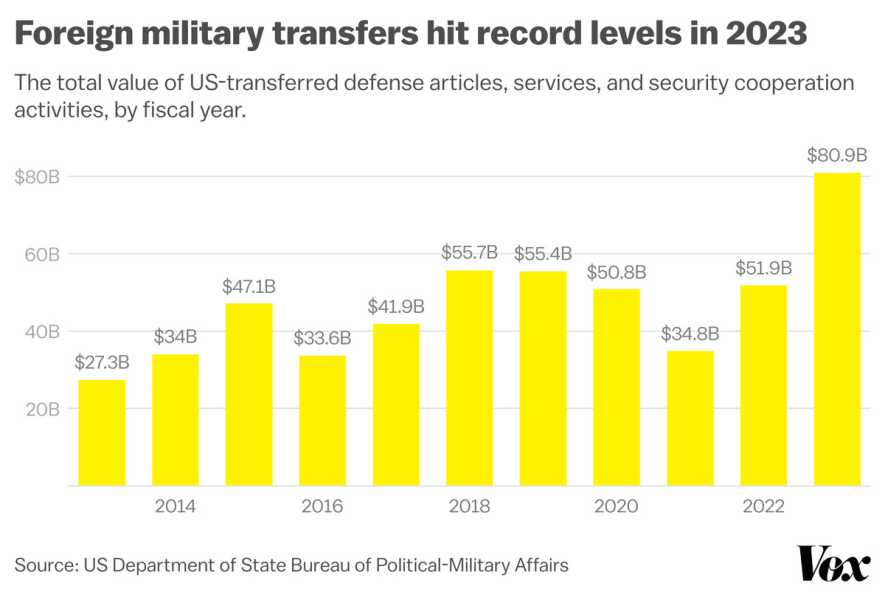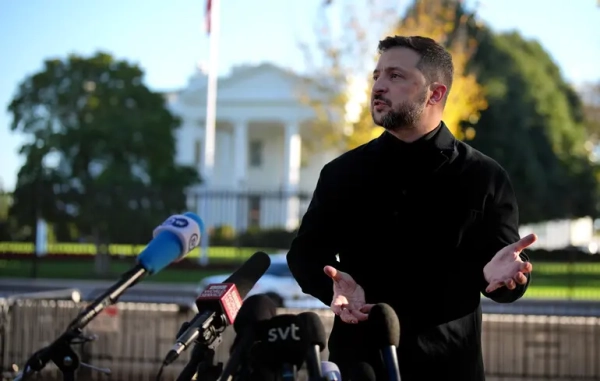Record arms exports are a sign of America’s commitment to Europe — and its foreign policy failures during the war in Ukraine.

A soldier of the 128th Separate Mountain Assault Brigade of the Zakarpattia Land Forces of the Armed Forces of Ukraine is seen during special training exercises to maintain professional skills involving T-72 tanks in the Zaporizhzhia sector of southeastern Ukraine. Dmytro Smolienko/Ukrinform/Future Publishing via Getty Images Nicole Narea covers politics and society for Vox. She first joined Vox in 2019, and her work has also appeared in Politico, Washington Monthly, and the New Republic.
US foreign military sales recently reached a record high, largely driven by Russia’s war in Ukraine.
The 2023 fiscal year, ending October 1, saw $80.9 billion in US government arms transfers, foreign defense services, and security cooperation — a figure up more than 55 percent from $51.9 billion in 2022. Direct commercial sales by US arms manufacturers to other countries also rose from $153.6 billion to $157.5 billion over the previous fiscal year. (The US government approves both types of sales but is only directly involved in negotiations for the former, making that a stronger indicator of US foreign policy priorities.)

Nicole Narea/Vox
US officials have indicated that they intend to starve the Russian arms export industry, encouraging their allies in Europe and globally to buy American weapons instead.
“We see that because Russia’s defense industry is denied the resources that come from exports, that helps to contribute to Russian strategic failure on the battlefield,” Mira Resnick, who runs the State Department’s Office of Regional Security and Arms Transfers, told Politico.
The military transfers also serve the purpose of signaling the Biden administration’s commitment to its European partners. Some European allies are buying US weapons in preparation for a feared broader war in Europe against Russia; the European Union approved $50 billion in funding for Ukraine Thursday.
Recent large-scale Russian investments in its army and weapons industry have fueled those fears. And Europe is worried that it may not be able to rely exclusively on the US for protection: US aid for Ukraine has run out, and a deal to secure additional funding in exchange for border security measures has stalled in the Senate following former President Donald Trump’s meddling.
But the increase in US arms sales is not necessarily a testament to the success of Biden’s foreign policy, said Elias Yousif, a research analyst with the Stimson Center’s Conventional Defense Program.
“This really reflects just a degree of insecurity in Europe and anxieties about the war in Ukraine,” he said. “I’m not sure that the acceleration of arms transfers is really a cure.”
Every one of these foreign military transfers goes through a detailed agency review process that involves evaluating whether it serves a partner country’s legitimate self-defense, and most major sales have to be approved by Congress with rare exceptions for emergencies.
These deals are often completed over multiple years. The $80.9 billion figure encompasses deals that were actually implemented over the last fiscal year, but the US has also announced some major deals with European allies that may not yet count towards that total: Ukraine’s neighbor Poland, for example, struck a series of deals amounting to more than $45 billion, per congressional disclosures.
There’s a question whether those deals will actually be implemented going forward. Poland’s annual military budget is just $16 billion, and it also made a big purchase from South Korea last year, so “they’ll either need to jack up their military budget dramatically, or spread out payment over many years, or scale back their ambitions,” said William Hartung, a senior research fellow at the Quincy Institute for Responsible Statecraft.
While Poland made the largest commitment in the last fiscal year, the US also made sales agreements with other European countries, including ones valued at about $11.4 billion with Germany and $6.3 billion with the Czech Republic, as well as smaller deals with Norway and Bulgaria.
These massive deals will help reduce European reliance on Russian arms. But they should also be raising concern about how well the US is reassuring its allies and what it’s doing to decrease the demand for these weapons in the first place, Yousif said. In that sense, the increased military transfers reflect Europe’s uncertainty about the US’s commitments to its allies in an unstable world, as well as the US’s explicit attempts to placate them.
How the war in Gaza is impacting weapons sales
Israel’s war in Gaza wasn’t a factor in the 2023 increase in sales, since the war started after the fiscal year ended. Much of what’s being transferred to Israel now is part of sales that Congress was notified of in previous years, but the fulfillment of those orders has been accelerated since Hamas’s October 7 attack on Israel, Yousif said. In other words, those sales were already tallied up in previous years’ totals. But there are some new sales: Biden twice circumvented Congress to make emergency weapons sales to Israel in December, totaling over $250 million.
Much like the Ukraine war, Israel’s war in Gaza could become a major driver of arms transfers going forward as regional tensions escalate and US allies work to ensure their militaries are well supplied for any potential conflict. Arms deals could also be a part of any normalization deal between Israel and Saudi Arabia — an agreement the US had made great efforts to broker before the outbreak of the war.
“Next year could be the ‘year of the Middle East’ as regional tensions sparked by the Gaza war and the Biden administration’s desire to cozy up to Saudi Arabia to persuade it to join the Abraham Accords could spur large new sales,” Hartung said.
Regardless of what happens with other partners in the Middle East, arms transfers to Israel appear likely to continue. That’s despite the fact that continued sales to Israel “violate the spirit and letter of US law as well as stated Biden administration policy, and they make a mockery of the administration’s claims to support a ‘rules-based international order,’” Hartung said.
Some foreign affairs experts have argued that existing US laws meant to safeguard human rights, including the “Leahy Law,” should have long restricted the flow of such assistance to Israel due to the high death toll in its conflict. Unlike with respect to Ukraine, whose use of controversial weapons like cluster munitions and landmines has led to restrictions on US aid, that law has not been adequately enforced against Israel, they say.
But the Biden administration has maintained that it is abiding by the law and is on track to make 2024 another strong year for weapons sales.
Sourse: vox.com






